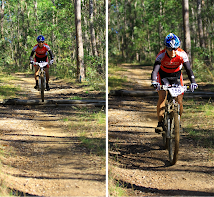
Oct 2008- Chixulub
After the Cancun Half Ironman we made Chixulub, a small fishing village on the Yucatan Peninsula our home and training base for 10 days. We had originally planned to base at my sister's house in Merida but an important person at the local 50 metre pool wouldn't let us swim there. So David, my sister's great friend and professional "problem solver" suggested we relocate to his cousin's beach housed to peddle between the villages, run on the beach and swim in the sea.
We lived the high life for those ten days in the village. We hired a scooter and our little house came complete with a dog (or maybe even four), a gardener (he appeared one day and offered to fix the garden for a small fee) and running water (most of the time).
In between outsmarting mosquitos on the hammock we peddled between farming villages, mangroves, sleepy fishing communities, pink flamingoes and cenotes. If you ever mention you are travelling to Yucatan to someone who has been there they will tell you about the cenotes, and I can see why. Temperatures were generally so hot that the notion of bike riding for fun seemed slightly obsurd. I reasoned against this by selecting a cenote as the object of every ride. To be honest I only actually got to the cenote about half the time, as something unexpected would often change the course of the ride. But the strategy worked well and I peddled many miles in those few days.
I want to share these experiences of training on the Yucatan Peninsua because I found very little information on the net about cycling in this area, and after going there I'd highly recommend it to others.
What I loved about cycling in this area on the Yucatan Peninsula. For starters, I peddled on some of the quietest roads I've ever ridden. I spent a lot of time pondering how the roads could be so good and yet so little utilised. Jeff suggested it was because there were no cars on them and that seems quite a plausible answer.
My longest ride was about 190kms. I followed the coast for 75kms through tiny villages until I got to the beautiful fishing village of Dzilm Bravo. When I turned to the sea I looked out at about 30 little wooden fishing boats, gracefully sleeping in front of the town, then I looked west and must have seen another hundred boats. In each boat I saw a family and an honest if small income from the sea, but in the whole fleet I saw an industry, quietly providing for the village and the other villages inland of this town. My camera wasn't with me, but I won't forget the image of the boats at Dzilm Bravo.

From here I peddled inland to a village called Gonzalas. There was something happening here. A small bullring was constructed in the main square and festivities were going on. Ignorant me, with no understanding of Spanish, had to peddle through the town in awe and wonderment about the goings on. Maybe the festival only lasts a day, but I'll always think of that village as the festive on.
I suspect that at least one of the roads was an old Mayan one as it was perfectly flat, straight and free of potholes despite being built through a mangrove. The highlight of this road was the Pink Flamingos. The road went right through their munching ground. At first they just didn't seem real. I had heard of a Pink Flamingo but quite honestly I thought it was an alcoholic cocktail. I am better educated now.
A wrong turn at the end of my ride took me through one more village and brought me home in the mozzie hour, just before dark. I'd spent most of the day out there exploring and it was a wonderful feeling to come home with some many images gathered. I though out there on my ride, that this was how I wanted to see the world, from my bicycle.
In some ways I blended into the local Yucatan scene better than I did to some parts of America. In America, me and my bicycle were always drastically outnumber by cars. In Yucatan we were in the majority. On some roads I saw more bikes than cars and in the villages the standard family vehicle was tricycle. Admittedly there were no other Felt B2's around, and I'm quite sure I didn't see much lycra but because bikes and motos are very common in this, even the cars that were there were extremely curteous in sharing the roads.








.png)